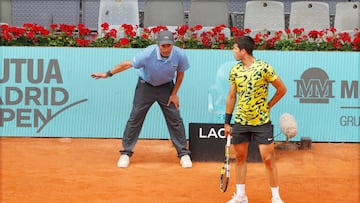What is Electronic Line Calling Live: does it mean the end for line judges in tennis?
The ATP has announced that from 2025, Electronic Line Calling (ELC Live) will be widely adopted, covering all lines.

Tennis continues to take steps towards the future. This Friday, the ATP announced that, starting in 2025, the circuit will adopt Electronic Line Calling (ELC Live) on a widespread basis to fully automate decisions related to the lines on the courts (whether a ball bounces inside or outside the permitted limits or whether or not there is a fault on serves), a job that, until now, had fallen to the linesmen. In recent years, technological tools (ELC Live and ELC Review) had coexisted with the referees; as a result of this decision, the work will be fully covered by the aforementioned electronic systems.
The ATP has announced Tour-wide adoption of Electronic Line Calling Live (ELC Live) from 2025.
— ATP Tour (@atptour) April 28, 2023
Read more ⤵️
“The move is set to optimise accuracy and consistency across tournaments, match courts and surfaces, for players competing in both main draw and qualifying events,” the ATP said in a statement. “The decision was supported by extensive research conducted by ATP across tennis stakeholders, including fans, which identified accuracy and consistency as the most important factors in assessing different line-calling systems”.
ATP Chairman Andrea Gaudenzi added: “This is a landmark moment for our sport, and not one we’ve reached without careful consideration. Tradition is core to tennis and line judges have played an important part in the game over the years. That said, we have a responsibility to embrace innovation and new technologies. Our sport deserves the most accurate form of officiating and we’re delighted to be able to deliver this across our whole Tour from 2025”.
ELC Live is clay court ready!🎾 💥
— Hawk-Eye Innovations (@Hawkeye_view) May 22, 2024
Our innovative journey continues in collaboration with the @atptour as our real-time Hawk-Eye Live Electronic Line Calling (ELC) system is now ready for events across all surfaces, including clay!#HawkEyeLive #ATP #ClayCourtReady pic.twitter.com/JkaA70I04I
More analysis, more statistics
Beyond their fundamental function, the ELC systems, which will be improved, will also offer an unprecedented amount of statistics. With their implementation, exhaustive monitoring of both players and balls will be possible, a novelty that will be optimized by Tennis Data Innovations (TDI).
It will be the definitive step for the circuit within a technology, that of automatic line control, which began to be tested at the 2017 Next Gen ATP Finals in Milan. Since then, its implementation had been voluntary, making coexistence between the systems and the line judges possible; from 2025, all the work will be the responsibility of technological tools.
Electronic Line Calling is basically an extension of the Hawk-Eye system that was introduced in 2007 to assist with the correct calling of decisions. Hawk-Eye uses 10 cameras that capture 60 high-resolution images per second, following every strike and bounce of the ball, not just the ones we see on screen when a player challenges a call.
For the 2024 edition, Roland-Garros collaborated with @Hawkeye_view, innovating for the benefit of its viewers.
— Roland-Garros (@rolandgarros) June 21, 2024
LiveAR was deployed to enhance the broadcasting experience with augmented reality replays.
Move the lines, with style.#RolandGarros pic.twitter.com/oMLpnYJOVi
ELC is an upgraded system as calls are made in real-time rather than after reviewing a replay on-screen.
What does that mean for line judges? It looks like they will soon be replaced although the on-court chair umpire will remain to oversee games and make sure match rules and regulations are followed.
Related stories
ELC was first employed at the 2017 Next Gen ATP Finals in Milan and overall, the system was considered a success.
As ATP Executive Chairman and President Chris Kermode said at the time, “The sports and entertainment landscape is changing rapidly, as are the ways in which fans are consuming our sport. This event is not only about the next generation of players, but also about the next generation of fans”.
Complete your personal details to comment